As more and more platforms move towards visual content, social media design has become increasingly important. Sure, your content is what really matters, but if your posts are visually unappealing or lack any sort of design consistency, they’re going to be lost in the mix.
But what if you don’t have an in-house designer? What if you don’t have any formal design background at all? Fear not–here are 10 social media design tips to help your posts stand out on the feed.
Bonus: <span style="text-decoration: underline;">Get the always-up-to-date social media image size cheat sheet.</span> The free resource includes recommended photo dimensions for every type of image on every major network.
What is social media design?
Social media design is the practice of creating visuals for social media platforms such as Instagram, Facebook, TikTok, Twitter, and more. This includes posts, stories, profile images, graphics, and other visuals to help support your content strategy.
Social media design is important because it helps create brand recognition and adds to the overall aesthetic of a page or profile. It can also be used to make posts stand out in a crowded feed or to capture the attention of potential followers.
For example, a travel brand might use a combination of high-quality photos and professional graphics that feature bold colors to create visually appealing posts. Or a bakery might rely on bright and colorful visuals like pastel frosted donuts or cupcakes with creative typography overlays.
10 important social media design tips
When creating your own social media design, there are a few things to keep in mind.
1. Build a clear visual strategy
Great visuals are only as good as the social strategy that supports them. Your social media design may follow best practices, but without purpose, narrative, timing, and other strategic elements, you’ll be doing your art department a disservice.
Whether you know it or not, all companies have a brand identity and visual language on social—some are just more fluent on social than others. A social media style guide can help with this.
Every visual strategy should include the following:
- Audience research. Do some background on your audience’s interests and think about what type of visual content they’d like to see.
- A mood board. Add content, color palettes, and other visuals that will help shape your direction.
- Themes. Mix things up with recurring themes or pillars. Air France’s Instagram feed, for example, includes a combination of destination shots and airplane photos.
- Platform. Consider how you should adapt your visual strategy for each social channel.
- Timing. Make sure to post visuals on social at peak times. But think big picture, too. Will you need more visual content around certain holidays? Planning ahead will help you better manage your budget and production calendar.
2. Know your design basics
What makes a great social media post design? If you can’t answer this question, a little studying may be in order.
Sure, there’s not one good way to create a social media post. But, there are some basic best practices to take into consideration:
- Have a clear subject. It’s usually best to have a single focal point in your image.
- Remember the rule of thirds. With some exceptions, it’s best not to center your subject perfectly.
- Use natural light. If your image is too dark, it’s harder to see. But don’t overexpose your images, either.
- Make sure there’s enough contrast. Contrast provides balance, is easier to read, works better in black-and-white environments, and is more accessible.
- Choose complementary colors. Get familiar with a color wheel.
- Keep it simple. Make sure your visual is easy to understand.
- Don’t over-edit. Resist the temptation to press all the buttons. Subtly is a good policy when it comes to filters and features. Increase saturation with caution.
Here’s a primer on how to take good Instagram photos—but the same rules apply to all types of social media photos.
3. Take advantage of free tools and resources
It’s almost always best to hire a photographer or graphic designer to create custom content for your brand. But if your budget is tight, or you’re in need of a few extra tools, there are countless resources available to help you create eye-catching social media designs.
Here are some of the best social media design resources and tools:
- 38 resources for free stock photos
- 72 free and customizable Instagram Story templates
- 5 free Lightroom Instagram presets
- 24 of the best Instagram apps for editing, design, and more
- Free templates for Facebook cover photos
- 7 ideas for your next Instagram grid layout
4. Watch out for copyright
Sourcing images for social media isn’t always easy—especially when it comes to understanding image copyright. But it’s important, especially since there are serious consequences for misuse.
Read all the fine print when using stock photos, templates, and illustrations. If anything is unclear, inquire with the image owner or site for more detail.
The same goes for licensing and contracting. When drawing up contracts with artists, it should be clear where you intend to use creative, who owns the rights to it, etc.
When it’s called for (which is often), be sure to give credit where credit is due. That’s also true if you plan to repost or share user-generated content.
5. Size images to spec
One of the biggest crimes you can commit when creating social media designs is using the wrong image size.
Images with the wrong aspect ratio or low resolutions can be stretched, cropped, and crunched out of proportion—all of which reflects poorly on your brand.
Every platform has its own specifications, and you should tailor your content accordingly. We’ve assembled a social media image size guide to help you.
A few social media image sizing hacks:
- Optimize horizontal Stories. Want to share a horizontal photo in a Story? Create a background or use a template, so it doesn’t look small and sad.
- Consider all devices. Stories and other vertical content display differently depending on the device being used. Check your analytics to see what devices your audience uses. If there’s a trend, size accordingly.
- Pay attention to pixels. Don’t put anything important in the upper and lower 250-310 pixels.
- Preview before posting. Preview how Instagram will crop a vertical photo on your grid by looking at the filter thumbnails before you publish.
6. Be tasteful with text
Whether you plan to create quote images, stylized typography, or use text overlays, less is always more when it comes to word count.
Text in social media design should always be bold, legible, straightforward, and concise. Make sure there’s enough contrast between the text and background so that it’s readable. The Web Content Accessibility Guidelines (WCGA) recommend using a contrast of 4.5 to 1. There are several free contrast checkers available if you’re not sure how to do this.
Here are a few tips to keep in mind when including text in images:
- Spell-check. Triple-check spelling and grammar. Tools like Grammarly and Google Docs can make this easy.
- Choose the type wisely. Font can affect both tone and legibility.
- Mix fonts carefully. If you need to mix fonts, pair a serif with a sans serif.
- Be color savvy. Avoid green and red or blue and yellow color combos. According to WCAG, they’re more difficult to read.
- KISS (keep it simple, stupid). Keep line length short.
- Look out for orphan words. Leaving one word on the last line can look odd.
- Get moving. Animate text to make it stand out.
7. Be mindful of representation
Do the people in your creative reflect the diversity of your audience? Are you reinforcing gender or racial stereotypes with your visuals? Do you promote body positivity?
These are a few of the questions you should be asking when making your next social media graphic design.
Doing so is not just socially responsible; it’s smart. It’s much easier for someone to imagine themselves using a product or service if they see someone that looks like them doing it. Look at your audience analytics or the demographics of your desired market, and factor them into your creative process.
Representation should be about more than just optics. If you have the means to diversify your team, do it. Hire women and creators of color. Bring as many perspectives to the table as you can.
At the very least, try to get feedback from as many voices as possible before sending your creative off into the world.
Here are a few inclusive stock photo libraries you can pull from:
- Refinery29 and Getty Images’ The 67% Collection promotes body positivity
- The No Apologies Collection expands Refinery29 and Getty Images’ body inclusivity collaboration
- Vice’s Gender Spectrum Collection offers stock photos “beyond the binary”
- #ShowUs is a collaboration between Dove, Getty Images, and Girlgaze that breaks down beauty types
- Disability:IN offers free inclusive stock photography for public use.
- The Disrupt Aging Collection by Getty Images and AARP fights ageism with its stock photo library
8. Prioritize accessibility
Not everyone experiences visual content the same way.
When producing your social media designs, make them accessible to as many people and contexts as possible. Accessible content allows you to reach a broad audience and possibly edge out non-inclusive competitors in the process.
More importantly, it helps you earn respect and loyalty from customers.
Accessible social media designs can include:
- Alt-text descriptions. Alt-text allows the visually impaired to appreciate images. Facebook, Twitter, LinkedIn, and Instagram now provide fields for alt-text image descriptions. Here are some tips for writing descriptive alt-text.
- Subtitles. All social videos should include captions. Not only are they crucial for hearing-impaired viewers, but they also help in sound-off environments as well. Language learners also benefit from subtitles. Plus, people who watch videos with captions are more likely to remember what they saw.
- Descriptive transcripts. Unlike captions, these transcripts describe the important sights and sounds that aren’t spoken or obvious. Descriptive audio and live-described video are other options.
9. Optimize for SEO
Yes, your social media designs can and should be optimized for search engine optimization (SEO), too. Social media SEO involves adding keywords, title tags, and image alt text to improve the visibility of your posts in search results.
Consider using keywords when designing social media graphics and creating captions for posts. Additionally, make sure to use descriptive language that relates to topics associated with your post and brand. This will help people find your content on social platforms by typing it into a search bar or clicking on related hashtags.
For example, if you are designing social media graphics for a clothing store, you might consider using keywords such as “fashion,” “style,” and “clothing” in the captions and titles. Use hashtags associated with your content to increase visibility on social platforms.
10. Be creative
Pshhh, easy, right?
But seriously. Forget the awards; creative work is always rewarded by customers with likes, comments, shares, and sales. And it has to power to earn new followers, too.
Having trouble coming up with social media post design ideas? Here’s a little inspiration for you.
Venmo uses social media graphic design to create a hypnotizing motion graphic.
Meow Wolf uses a creative carousel to tell a story beyond the caption.
Bon Apetit Mag uses bold, colorful designs to announce its latest best-new restaurant winners.
The Washington Post adapts listicles for the Instagram carousel.
All Birds takes a design-forward approach to static social media graphics.
National Geographic uses simple text on images to attract user attention on a busy Twitter feed.
Go behind the scenes with five National Geographic photographers who crisscrossed the world https://t.co/iliTVod0Up pic.twitter.com/22ztNlAIyI
— National Geographic (@NatGeo) November 18, 2022
5 social media design tools
Now that you’ve seen examples of social media graphic design in action, let’s take a look at some tools you can use to create engaging visuals.
Canva for Hootsuite
Canva for Hootsuite is a great option for creating on-brand designs right from your Hootsuite dashboard. You can view recently created designs as a content source, and add previously created designs from your Canva folders. Once you’re done, attach your social media design to the Hootsuite Composer and publish it straight to your accounts.
Plus, leverage Canva’s library of beautiful social media design templates without ever leaving Hootsuite. This means you can quickly create stunning visuals that adhere to your brand’s guidelines and save time while creating beautiful content.
Canva
If you’re looking for a tool to make professional-level social media graphics, look no further than Canva. With its simple drag-and-drop interface, you can create high-quality visuals in just minutes. Choose from thousands of templates, or start with a blank canvas to design posts that match your brand’s aesthetic.
No matter your design needs, Canva has you covered. You can create everything from stunning social media post designs to full-fledged graphic layouts for a range of purposes. To make things even easier, Canva also provides access to its library of stock photos and illustrations, so you don’t have to hunt for images elsewhere.
Easelly
Tired of spending hours designing perfect social media designs? If so, Easelly may be the design tool for you. This free platform is designed to help users create beautiful infographics in a matter of minutes. From choosing from ready-made templates to customizing your own designs, Easelly can assist with almost any graphic design project.
Easelly also has a wide range of social media design templates you can customize to match your brand’s aesthetic. All you need to do is select a template, add your images and text, and voila! You can have an eye-catching social media post design in no time.
Adobe Express
Is Photoshop too advanced for you, but you still want to create stunning social media graphic designs? Adobe Express may be the solution. This design tool offers over 34,000 templates that can be customized using its simple drag-and-drop editor. Plus, you can also upload your own images and icons to personalize your designs further.
On top of offering easy-to-use templates for graphic design, Adobe Express also allows you to create beautiful video content for social media. By selecting from their library of social media-specific templates, you can have an eye-catching video ready in no time.
Pixlr
Designing for social media doesn’t have to be complicated. With Pixlr, you can create beautiful social media post designs with ease. This photo editor doubles up as a design tool and offers features such as collages, photo filters, and layers that let you quickly transform your images into stunning works of art. Additionally, it also comes with various pre-made templates and effects that make designing for social media quick and easy.
How to hire a social media designer
Okay, so maybe you don’t have the time or the skills to design a social media post yourself. That doesn’t mean you can’t get your hands on some fantastic designs for your social media channels. Fortunately, there are plenty of talented graphic designers out there who specialize in creating custom graphics for social media profiles.
When looking for a social media designer, look for one who has a keen eye for aesthetics and knows how to use colors and graphics to create an eye-catching image or video. You should also find someone with experience in creating graphics that are optimized for the platform you’re targeting (Instagram, Facebook, Twitter, etc.).
When it comes to pricing, most graphic designers charge an hourly rate for their work. Depending on the complexity of your project, you can expect to pay anywhere from $50-$100 per hour (or more). Some designers offer package deals that include several social media graphics for a fixed rate.
If you’re looking to create a long-lasting visual aesthetic for your feed, ask your designer if they can make you a set of custom Canva templates. These templates will save you time and make it easier to post consistently on social media.
When selecting a graphic designer, check out their portfolio to get an idea of their design style. If they specialize in creating visuals for social media, they should be able to provide previous examples that are optimized for the platform you’re targeting. Don’t forget to also look at their reviews to see if other clients have had positive experiences with them.
Social media design FAQs
What makes good social media design?
Good social media design is visually appealing and eye-catching while also conveying a clear message. It should be easy to understand and optimized for the platform you’re posting on. Your social media designs should also adhere to your brand style guide so that viewers can identify them immediately as belonging to you or your business.
Why is social media design important?
Social media design is important because it helps to establish a consistent visual identity and messaging for your brand. It can also help you stand out from the competition and increase engagement with your posts. A good social media design strategy can also help you build trust and loyalty with followers, as well as grow your reach and visibility online.
What are the different types of social media design services?
Social media design services can include creating graphics for posts, designing page layouts, producing video content, and creating infographics. It can also involve creating custom designs for ads, developing a style guide for your brand’s social media accounts, and optimizing posts for maximum engagement. Professional designers who specialize in this area typically have extensive experience in graphic design, marketing, and branding.
What should I prepare for my social media designer?
When hiring a social media designer, you should have a clear idea of what kind of content and design you are looking for. You should also provide any and all relevant information, such as brand guidelines, existing logos or icons, messaging briefs, and examples of similar work that they can draw inspiration from. Additionally, it’s important to discuss your budget upfront.
Looking to stand out online? Social media design is just the start. Create, schedule, track, and optimize your content all on the Hootsuite platform. Try it free today!
Better content in half the time
Boost engagement and save time with a hashtag generator, post templates, Canva, and Grammarly Pro in Hootsuite.
The post 10 Social Media Design Tips to Stand Out on the Feed appeared first on Social Media Marketing & Management Dashboard.

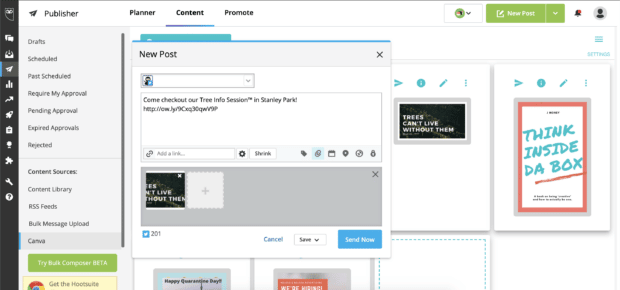
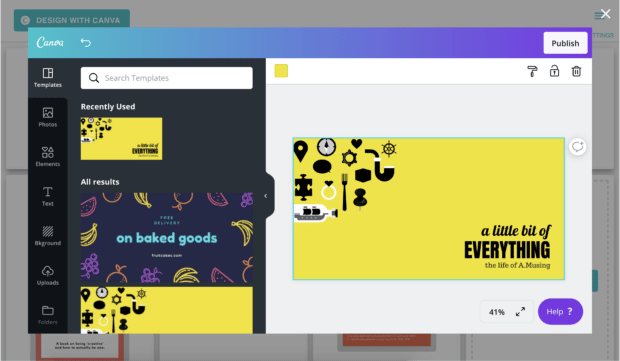
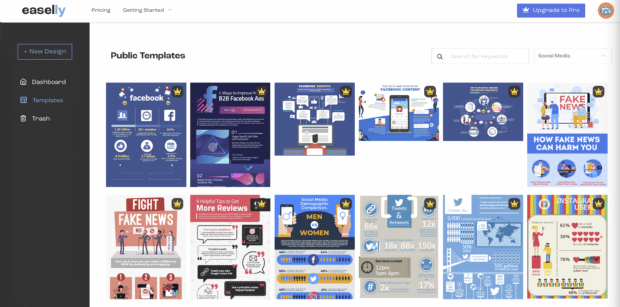
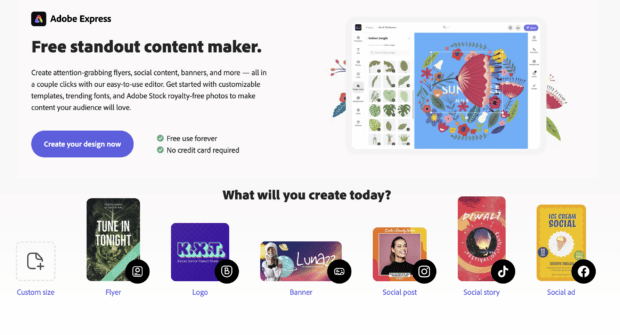

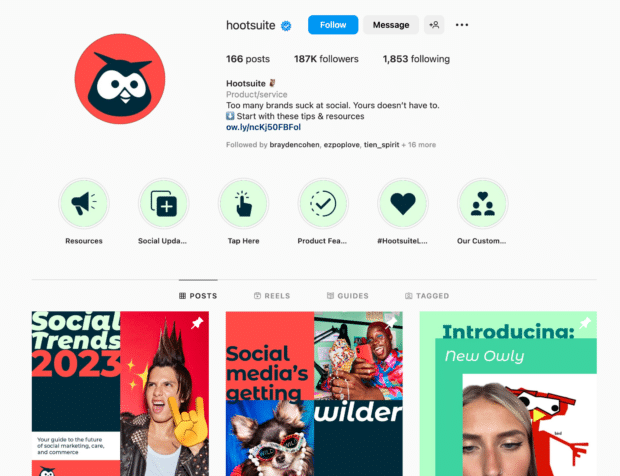




Recent Comments